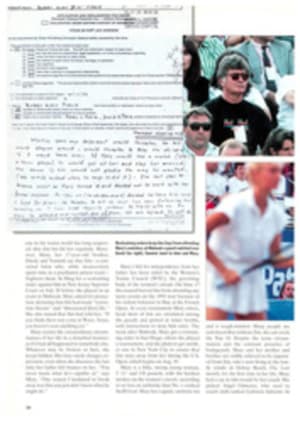
These Waves Win Raves
Eight-time professional body-boarding champion Mike Stewart has nearly vanished in the barrel of a towering eight- or nine-foot wave. Only his blond hair and the nose of his board are visible deep in the arcing white-water tube. Finally he emerges, wriggling, pumping hard on his board. Stewart carves out a couple of cutbacks and then executes a perfect 360-degree spin.
Other pros, all of them warming up for a competition the following weekend, on May 22 and 23, go for barrel rolls in the tube or huge aerials, shooting up and over the face of the waves before snap-turning back down at frightful angles. Spectators and competitors alike alternately whoop their approval or groan at some truly horrendous wipeouts.
This isn't Hawaii. Or California. Remarkably, this near-perfect surf is breaking deep in the heart of Texas, a good 150 miles from the Gulf of Mexico. What's going on?
On, it happens, is the operative word. Forget the old cry: Surf's up. Here in New Braunfels, at the innovative Schlitterbahn Resort and Waterpark, the surf is on. And the man-made waves are getting rave reviews. Stewart, 30, from Hawaii, likens the ride to river-surfing standing waves—only better. "The difference is," he says, "this has got a tube, which is pretty ultimate. That's the quest when you're surfing, a tube ride."
"You don't get the saltwater, and it's not like you're in paradise," says Seamas Mercado, a 23-year-old bodyboarder from Hawaii. "But this thing is incredible. If you get it right, you can sit there for days in the curl, everybody telling you to get off. Riding this wave for 10 minutes straight would be like riding for months in the ocean. It's a dream come true.
"I just want to thank you for making this thing. Thanks a lot, man," says the dripping wet Mercado to 40-year-old Tom Lochtefeld, who stands at the railing of a canopied set of bleachers overlooking the roaring stream of chlorinated water that could give surfing its biggest boost since the Beach Boys and Endless Summer. The lanky Lochtefeld wears a cap bearing the words FLOW RIDER, a day's beard and a look of mellow satisfaction. Later today he'll meet with a group of Japanese businessmen who want to put a small version of his Flow Rider in a shopping mall near Tokyo. Next week he'll be at a water park in Norway to help turn on an even bigger wave. Momentum is building, but there has been a lot of water under the dam to get to this point.
One day in 1987, Lochtefeld asked himself, What is the essence of surfing? He was thinking physics, not philosophy, though he was looking for a new path in life. He had already gone through several careers. Successful real estate speculator. Lapsed tax attorney. Most recently Lochtefeld had stayed dry on the business end of two water parks in California and one in Salt Lake City. But the wet side called to him. Surely, nagged his surfing alter ego, he could improve upon the lame, mushy, barely cresting breakers that are cranked out in most water-park wave pools. Then it dawned on him. Forget the pool. A surfboard rides on only a few inches of water. "You don't need the whole wave, you just need the top layer," says Lochtefeld.
His first pursuit of a new kind of artificial wave took place in his Jacuzzi. Lochtefeld hooked up some hoses to the spray nozzles and aimed various flows at a handheld, curved sheet of plastic. Encouraged by the tiny waves, he rigged up bigger flows by his swimming pool. Before long he and legendary surfboard designer and manufacturer Carl Ekstrom were working side by side, shaping crude models they would later test in the water tanks at the nearby Scripps Institute of Oceanography. Finally Lochtefeld spent $10,000 to jury-rig a full-sized prototype at a water park in Los Angeles. He hired laborers to fill 1,000 sandbags, dammed a couple of flow channels to create an elevated reservoir and built a ramp out of linoleum-covered plywood. The first release of water boiled over the top of the incline, creating an unrideable mess. But when Lochtefeld reangled the ramp, not only could he ride the wave on a body-board, but so did an intrigued carpenter who had never surfed a day in his life.
This early wave had no curl. Nor does the tamer Flow Rider that Lochtefeld built at Water Mania in Kissimmee, Fla. A wave with a curl would not only take guts to ride, it would also take a gutsy water park to look past the liability concerns and sink about $1 million into Lochtefeld's invention. Jeff Henry, part-owner of the family-held Schlitterbahn Water-park, jumped at the chance.
Henry brought more than money and enthusiasm to the project. He had perfected a soft-foam coating for water-park slides, pool bottoms and such fanciful kiddie-pool objects as squirting fire engines. He used it to cover the sweeping U-shaped concrete curves of the 40-foot wide wave maker—at Schlitterbahn called a Boogie Bahn—that he and Lochtefeld designed to flush washed-out boarders into the park's gently flowing Lazy River.
The man-made river also serves as Flow Rider's water source. Pumps transport 100,000 gallons a minute to a 16-foot-deep storage tank directly behind the bleachers. On the bottom of the tank at the top of the incline opposite the bodyboarder are four hydraulically controlled gates. Raising them a few inches unleashes a tremendous roar as the under-the-dam pressure forces an ankle-deep layer of water to rush down the incline to the bottom of the U and up the other side, forming a wave deep enough and powerful enough to capture a bodyboarder and his or her fancy. Working levers like a crane operator, someone in the control booth can either serve up the typical water-park challenge, a fast rushing flow without a curl, or—after hours or for professional competitions—summon a monster wave by directing the maximum torrent toward the typically unused far portion of the surface and up the padded nine-foot wall that molds the tube.
A local high school student named Heath Purvis has logged so many nighttime hours at Schlitterbahn that he is more than able to hold his own against the pros. Despite having ridden in saltwater only a couple of times in his life, Purvis makes it all the way to the semifinals of the competition. He reaches the semis largely because of some crowd-pleasing "spinners," two, three and sometimes four consecutive spins that he begins down in the flats and continues up the face of the wave. Pressing for four, Purvis loses his bearings, winds up high on the wall and gets sucked into the vortex of the tube. He tumbles head over heels and snaps his collarbone. The kid is tough. He dives back on his board one more time to finish his competitive round.
But Purvis isn't yet one of the guys in a rainbow-colored wet suit. While visiting Brian Press in California not long ago, Purvis rode the ocean waves well enough; it was the paddling out he had trouble with. Says Stewart, who is something of a grizzled veteran and winner of last year's Flow Rider championship, "It's kind of weird, but this park is indicative of this era, where it's instant gratification. This wave takes everything out of the surfing experience except for the riding, which is the essence of it." Stewart then proceeds to honor the other dimensions of ocean bodyboarding: paddling out, deciding which wave to ride and when to take off. Not to mention the Zen and the fear of "being by yourself a mile out at sea when the waves are 25 feet.
"It will never be what ocean bodyboarding is," Stewart says. Still, he and all the other pros queue up for practice rides like a bunch of giddy kids at a waterhole rope swing. Lochtefeld's wave has clearly sucked them in. The competition is really a glorified demonstration event. No money is awarded, only trophies. Says Stewart, the top sponsored rider in the sport, "I paid my own way here. I wouldn't do that for any other event."
Mulling over this new turn bodyboarding has taken, some of the riders envision an inland circuit of events that would bring new fans within intimate range of their sport. In the meantime Hawaiian bodyboarder Ben Severson, who was judged the winner of this year's Flow Rider competition, wonders about his transition back to saltwater. "The waves will probably be only a couple of feet," he says. "I'll be used to all this power."
PHOTO
TOM BOYLE
California's Press was one of many saltwater regulars who tried their boards in Texas.
ILLUSTRATION
PHILIP ANDERSON
Increasing the flow of water hitting the U-shaped Boogie Bahn creates gnarlier waves.
John Grossmann, who lives in Jamison, Pa., is a frequent contributor to Sports Illustrated.

